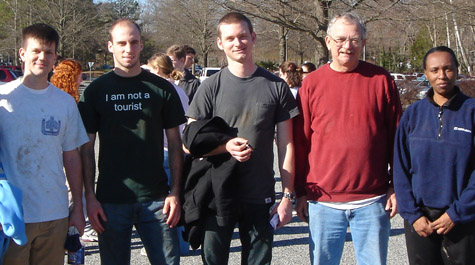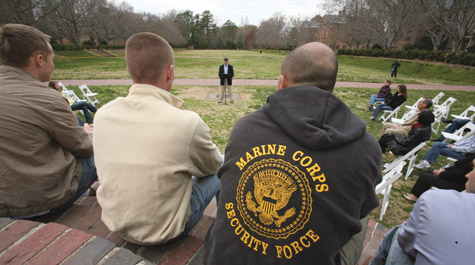Veterans Society of W&M here to help
Not many know it by its real name, but the Servicemen's Readjustment Act of 1944 changed the fate of the World War II generation and the America they called home. More commonly known as the G.I. Bill, this unprecedented legislation went a long way toward helping veterans achieve their higher education goals. Some have called it the most important bill of the 20th century.
The new G.I. Bill - technically the Post-9/11 Veterans Educational Assistance Act of 2008 and sponsored by Virginia Sen. Jim Webb - became law on Aug. 1, providing significant financial support to returning servicemen and women. Even with that, today's veterans still face a different set of challenges in higher education; the William and Mary Veterans Society exists to help veterans meet those challenges and excel in the College community.
In January of 2007, the Veterans Society was formed by a group of nontraditional students who had served the country in the various branches of its military. On April 30, 2009, the Society met to commemorate the greater William and Mary community's fallen soldiers in their third annual Moment of Remembrance, honoring siblings, friends and fellow veterans alike in front of a Sunken Garden dotted with hundreds of American flags. The ceremony is a somber but inspiring way to ensure the military's sacrifice is not forgotten, even on a campus surrounded by military installations.
Getting There
The first thing, though, is to get the veterans to come to campus. One of the Society's objectives is to make sure returning veterans recognize W&M as a feasible option for them.
"Me, for example, I didn't take the SAT and my high school grades weren't that great," says Lance Zaal '09, past president of the Veterans Society and an ex-Marine who served in Iraq. "There are many others who felt intimidated [by W&M]. What we like to do is help the other students who are thinking about applying to William and Mary and let them know that it's not impossible to come here."
Jeremy Stout '12 is not your typical transfer student either. On the one hand, some of his transfer credits come from Hawaii Pacific University; on the other, he spent four years as a Marine in Iraq.
"I wasn't very focused in high school - I couldn't afford college," he says. "I decided that I could serve for four years in the military and have my college fully paid for when I got out. It gave me life experience and time to figure out what I wanted to do. It shifted my focus in a serious way."
Stout spent his first tour of duty in Haditha, Iraq, as an infantryman. He returned for a second tour in Fallujah as part of a scout sniper platoon. Upon returning to the U.S., he applied himself and did very well at Hawaii Pacific and John Tyler Community College. He decided to submit applications to a number of schools including William and Mary - his "longshot" choice for a psychology degree.
"I actually got accepted to all the schools I applied to," he says. "In my mind, there was no question: William and Mary was the school for me."
Thanks to the new G.I. Bill, returning veterans like Stout have the opportunity to attend college - while having some or all of the financial burden borne by the government in return for their dedicated service. The new bill offers grant money to qualifying veterans in an amount equal to the most expensive in-state rate, per credit hour, although not all veterans qualify for the full amount, depending on criteria determined by Veterans Affairs. For in-state students qualifying for 100 percent of the Post-9/11 G.I. Bill money, that's enough for tuition. There are, of course, out-of-state veterans and graduate students for whom that doesn't cover the full tuition rate, and William and Mary's participation in the Yellow Ribbon program offers up to $2,000 per year, an amount then matched by Veterans Affairs. The new G.I. Bill also covers the $3,840 in student fees in percentages equal to the qualified tuition rates. The Veterans Society itself has also sponsored its own scholarship.
"It's a burden off my shoulders," says Stout. "I don't think I would have done as well as I'm doing now right out of high school. I care about my grades because what I had to do to get to this point was pretty difficult. Once you have that kind of motivation, it forces you to really work harder."
Navigating the Process
According to Associate Dean Kim Van Deusen of the Admission Office, nine veterans are slated to enroll for the fall 2009 semester, a nearly twofold increase from previous years. Thanks to the Common Application, she says, military service is no longer only self-reported - it has dedicated space on each application.
"This may sound like a such a small change, but I believe it's the right step in letting veterans know that we encourage their applications to W&M," says Van Deusen. "What's more important - that their background is significant and we want to hear their story in the admission process."
Beyond the application, the Veterans Society works to address the specific concerns of their nontraditional students. For example, the Society helps with housing recommendations for veterans, whether they are single, married or have a family. Their Web site, www.veteransociety.org, states: "It doesn't matter what they need, we are here to help."
Stout, having previously navigated the admission process, was able to help a fellow veteran and prospective student in his 30s by putting the student in touch with the people who had already assisted him.
"I just shared with him," Stout says. "He was very grateful for that. That's really what it's all about. It's about a Society that, when a veteran comes to this school and has any kind of trouble, uses our experience to help him out as much as possible."
Once they are accepted, Veterans Society members begin the main thrust of their project. Unlike veterans programs at other universities, Zaal says, the W&M Veterans Society strives to increase student-veteran relations and ease the transition back to civilian life. For Veterans Day 2008, the Society set up a paintball arena in the Sunken Garden and the winners donated the prizes to charity. The event also included performances from the Queens Guard, musical and multicultural groups and information from campus groups highlighting their contributions to the armed forces. Just another step, Zaal says, in linking the world of the average student with the experiences of student veterans.
"We realize that these students are younger and may be inexperienced - they're still important relationships," says Zaal. "By encouraging other members to get out there and participate in other campus activities and events and things like that, [veterans] will feel more welcome."
Esprit de Corps
That said, the Society also seeks to provide an outlet for veterans to continue the unique camaraderie and common bond of military service. The sacrifices made in combat, they say, may not be fully understood by the average student - nor the motivations. The Society's ability to share the common bonds of military service is a major asset.
"That's what it's really about; the comradeship," says Stout. "Because we have our own unique experiences as veterans. We're just there to lean on, when it comes down to it."
Jessica Watson '07, a past Society secretary and founding member, was a married student whose husband was living in Virginia Beach while she was attending classes at the College. After her service with the Marine Corps, Watson didn't initially feel entirely at home on campus.
"A social life in the Marine Corps was not a series of social events," she says. "It was constant teamwork and extreme dependability - because one's life depends on it.
"I adored my friends, but I needed a group of people who could understand what I had been through and why life was different for me," she says. "The Veterans Society offers a network of people who desire the similar camaraderie they experienced in their former career."
"They have a language amongst themselves when they're serving in the military," says Lizabeth Allison, professor of biology and a faculty liaison to the Society. "They get used to not talking that way [in civilian life] and they miss having that kind of rapport."
A Place in History
Today's Society is the latest military heritage group to trace College veterans' history. The Association of 1775 was an active constituent group of the William and Mary Alumni Association from 1991 until around 2004. Now, Zaal says, the Veterans Society also hopes to have a robust alumni community to complement what the Society is already doing for current students. He encourages alumni veterans to visit www.veteransociety.org and sign up for membership in efforts to expand and enrich the W&M veterans network.
"We hope to just share stories and to share experiences. I know some of us find it interesting to see what past veterans have done once they left William and Mary," he says. "I think that definitely widens our membership and our support base. We'd also like to have greater participation from alumni in the organization. That's why it is really more than a student organization."
Despite their unique needs and uncommon shared history, Stout says that today's veterans don't come to the College to receive any sort of special treatment based on their service.
"William and Mary is a hard school; it's a very traditional school and there's no reason it should be easier [for veterans]," he says. "We came here for that challenge. And to take away from that challenge is to take away from William and Mary."
 Skip to main content
Skip to main content


